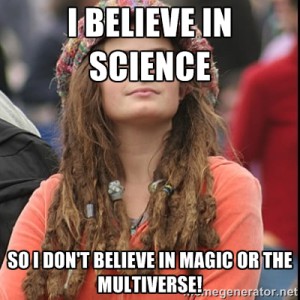When I was young, I recall that a standard assignment when restarting school was an essay on “what I did on my summer vacation”. Now that I’m back in the office after a vacation, here’s a version of that, covering the physics/math aspects:
- In Paris I visited the Palais de la Découverte, the science museum in the heart of the city. This was the site of some of my earliest memories of getting interested in science, back in the late 1960s. I started out by visiting the physics section, some of which looked like it hadn’t changed much since those days. One addition was a video screen with some seating nearby. It was running Particle Fever, and surely someone trying to annoy me had timed things so that I got there just as the part promoting SUSY finished, and the part featuring Nima Arkani-Hamed promoting the multiverse got underway.
Besides revisiting my youth, this made me wonder what the effect of trying to impress the young with glitzy pseudo-science will turn out to be. Will it turn off youngsters looking for something intellectually serious? What would my 12 year old self have made of this?
I soon made my way though to a big LHC exhibit, which cheered me up immediately. This was quite well-done, giving a good idea of what a machine like the LHC really is and what the scientists working there are doing. I quite enjoyed the last part of the exhibit, a recreation of typical grimy offices at CERN that people work in. I’d like to think that I’d have appreciated that, with its unspoken message that these are people who care not about appearances but just about the fascinating work they are doing.
- Now that scientific bookstores are gone in New York, checking out the ones in Paris is a high-priority when visiting there. This time I bought a few books in French, one of which was a new biography of Grothendieck, by Georges Bringuier. I’ve read widely among the many sources emphasizing Grothendieck’s mathematics, this is one that instead focuses on his life, including quite a bit about the years after he left the IHES in 1969. This is an amazing story, and there’s much in the book that I didn’t know, especially about Grothendieck’s mystical views.
The last years of his life he was a hermit, just about completely isolated and perhaps paranoid, but still supposedly writing (the biography explains his view that one shouldn’t read mathematics, but write it). Perhaps someday we’ll find out what he was writing about, for some information about this, see here. While in the earlier part of his career Grothendieck wanted nothing to do with physics, associating it with the Bomb, evidently at the end he had physics books in his home rather than mathematics ones.
One person Grothendieck was in communication with in the early 1990s was Robert Thomason, see a letter available here. Thomason died in Paris in 1995, his notebooks have just become available at this site.
- Another book I found in Paris was from a few years back, about the “unification of mathematics” by Parrochia, Micali and Anglès. The topics are Clifford algebras, abstract algebraic geometry (a la Grothendieck), and the Langlands program, wrapped up in an argument that these provide a unified framework for mathematics. The point of view is the very French one emphasizing the “philosophy” of a subject, and much of the argument is that philosophers of science should be paying close attention to the “Langlands philosophy” and its significance as a unifying set of ideas. They also argue that physics should fit naturally into this sort of unification, an idea I’m very fond of, but they don’t seem to be very aware of the actual connections between physics and the Langlands story (they refer only to the classification of branes by twisted K-theory).



